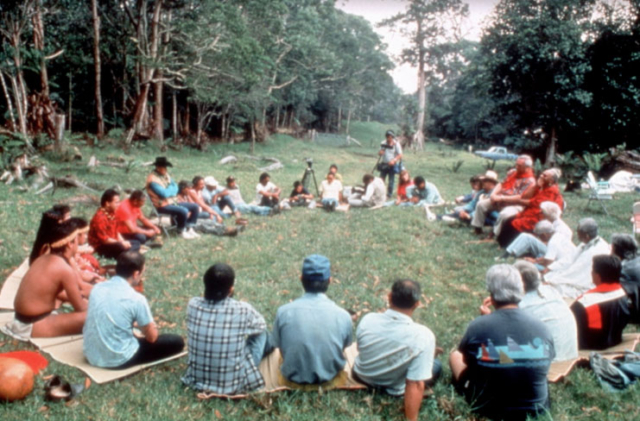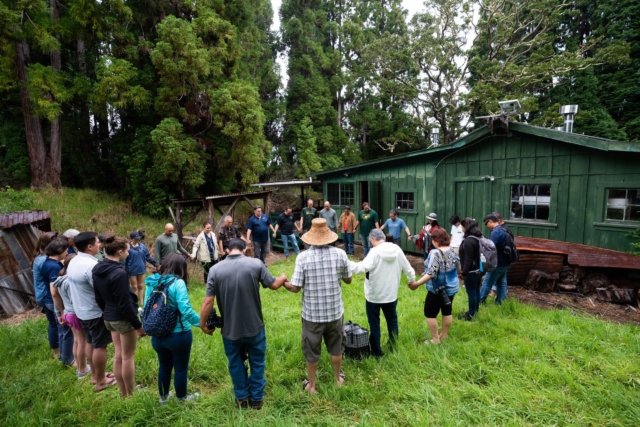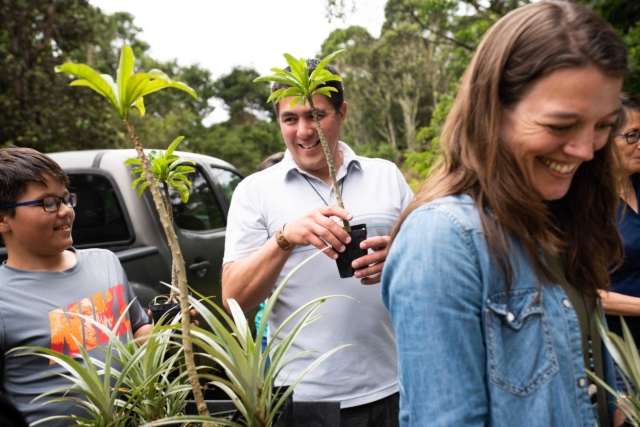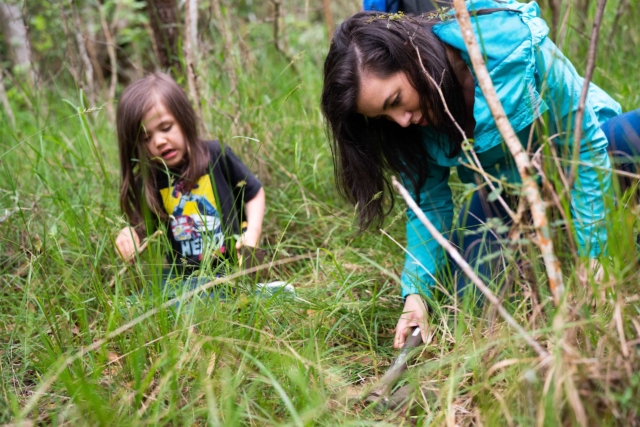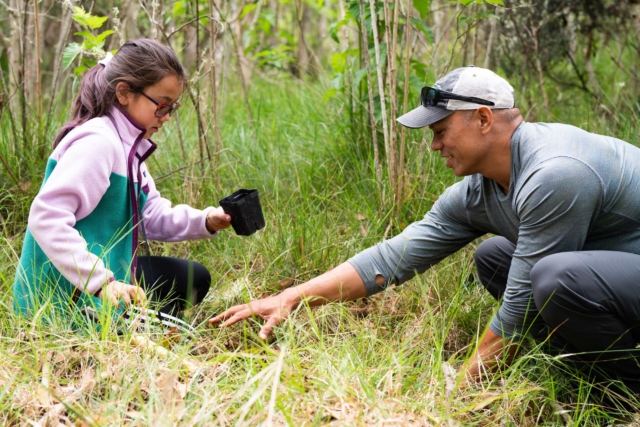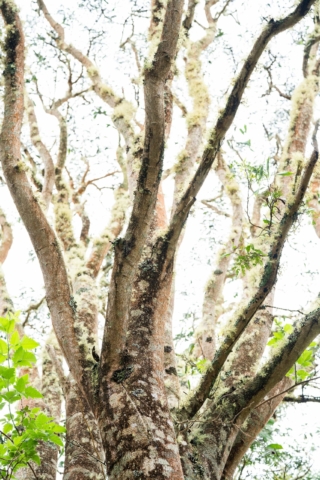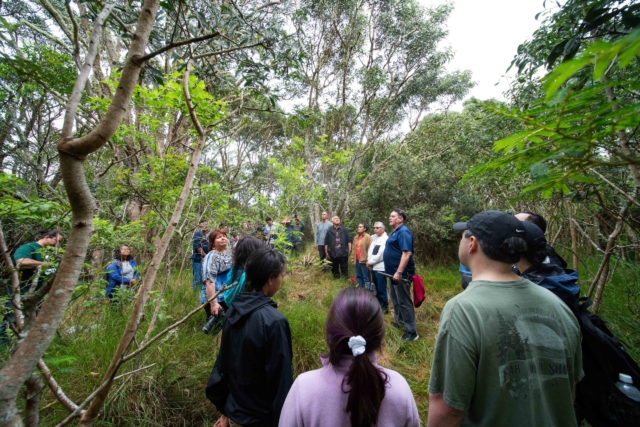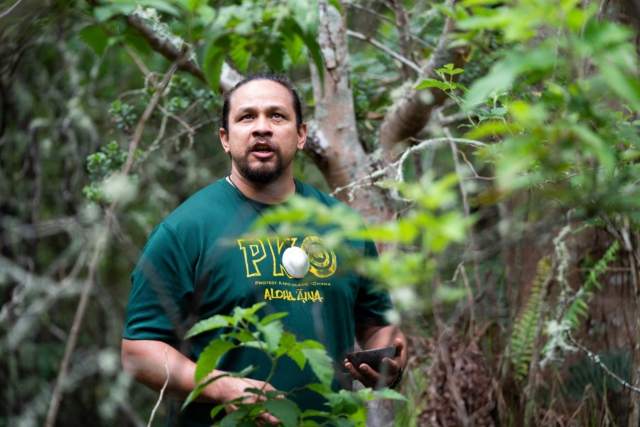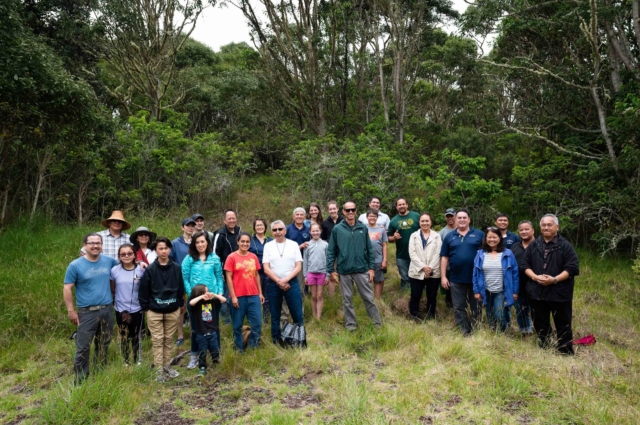
Returning to the Koa Forests After 30 Years
- Posted on 28 May 2019
- In Featured, Malama Honua, Malama Honua Selects, Newsletter, Photo Galleries, Teachers, Updates
Native forest visit reaffirms Hawai‘i-Alaska kinship and shared commitment to ancestral knowledge and nature
As a precursor to the Ho‘oilina Conference, Kamehameha Schools (KS) and the Polynesian Voyaging Society (PVS) hosted Sealaska leaders on a day trip to Hawaiʻi Island yesterday to revisit KS’ Keawewai and its native forest on the upper slopes of Keauhou where almost 30 years earlier, Native Hawaiian and Alaskan leaders gathered in ceremony to promote the restoration of Hawai‘i’s declining koa forests.

The visit back in 1990 was to accept the precious gifts of two Sitka spruce logs from Sealaska to build the Hawaiʻiloa canoe, and to affirm a commitment to restore Hawai‘i’s threatened forests.
The purpose of yesterday’s visit was to remember, honor and celebrate those acts of kindness that have strengthened the bonds of kinship between Hawaiʻi and Alaska and helped restore this sacred environment.

Participants of yesterday’s trip to Hawaiʻi Island included KS CEO Jack Wong and Executive Cultural Officer Randie Fong; Sealaska Chair Joe Nelson, President and CEO Anthony Mallott, and former President and CEO Byron Mallott; and Hōkūle‘a crewmember and KS West Hawai‘i Regional Director Kaimana Barcarse. The Mallotts and Fong were both part of the first visit to the area 30 years ago. Other cultural leaders who were part of the 1990 visit were Alaskan Tlingit tribe elder Judson Brown, Pinky Thompson, Herb Kāne, canoe builders Wright Bowman Sr. and Wright Bowman Jr., and Nainoa Thompson.


“Continuing to build relationships with Hawaiians and other indigenous people is important to Sealaska,” Sealaska President and CEO Anthony Mallott said. “The Hawaiian and Tlingit, Haida and Tsimshian people have a deep connection as ocean and canoe people, who are deeply tied to their environment. Good relationships between indigenous people who have common histories can help advance common goals.”
Yesterday’s visit started with a stop at Kīlauea to offer chant and request permission to visit the sacred land of Keauhou. After arrival at the native forest, the group was able to witness the growth of the forest since 1990 – a result of KS’ koa reforestation efforts that involved students and the community. Each person then planted native plants pa‘iniu and ‘ōhāwai followed by prayer, chant and reflections from the group about the importance of working together in unity to protect nature, as well as the knowledge and traditions of our ancestors.
Then and now: Thirty years ago the group planted for the future. Now they are nurturing a shared commitment to ancestral knowledge and nature.
“We planted seedlings back in 1990 at a site we are visiting today. The purpose of this is to say we honor that act, and we celebrate the past, and as we are celebrating and remembering we are planting new seeds for the future,” Fong said.
The following comes from our friend Sam Low via the PVS archives circa 1990… For more, visit http://archive.hokulea.com/ike/kalai_waa/low_sacred_forests.html
At the fence line separating the Kilauea Forest Reserve and the Keahou Ranch – a circle of about a hundred people joined hands for a prayer. They had spent most of the day replanting koa trees, now it was time to ask the akua to bless their work.
“When it became clear that we needed a step in between going to Alaska and cutting the tress down I felt a deep sense of relief and freedom,” Nainoa recalls. “We knew what we had to do to restore the balance – to be pono. We held the ceremony on the edge of the forest, on the fence line, just outside the reserve on the slope of Kailua.”
The circle of men and women joining in the prayer and the renewal of the forest was in some ways a microcosm of a new way of life that was emerging then in Hawaii – a way of life that combined keiki and kupuna, activists who worked on the front lines for the renewal of Hawaiian culture and those who worked quietly behind the scenes, cowboys and sailors, men and women of all races – an ohana of people created out of a common vision. Randy Fong was there from Kamehameha School to help conduct the ceremony. Kalana Silva, who was instrumental in Hawaiian language immersion, was there; also Robert Kekealani from Puuwaawaa, a well known kupuna of the ranch and forest; and Ricky Tavares, who had been the ranch manager for Keauhou Ranch and who helped guide Nainoa through the reserve to look for the trees. Also in the circle were many members of Hokule’a’s crew – Tava Taupu, Shorty Bertelmann, Clay Bertelmann, Chad Baybayan and others. Nainoa’s parents were there along with Agnes Cope and other board members of the Native Culture and Arts program. And there also to join hands was John Dominis Holt.
“John knew that I had to search for the answer at a level that was much deeper than the intellectual,” Nainoa explains. “I could not cut the trees down because it felt wrong for the environment, but it was deeper than that. When we put our thoughts about the environment over here and we put our feeling of na’au over there and we have no link between them, we feel disconnected. Our sense of balance is destroyed. Walking out of the forest with Tava was painful because we had destroyed that very sacred place, our koa forest, and that hurt at a very deep level. It was much more than an environmental issue. We hoped the replanting would send a message about replacing abuse with renewal. It was symbolic of making choices that we all felt very good about. All of us. It laid the groundwork for a new emphasis within the Polynesian Voyaging Society – a new program that we call Malama Hawaii – an opportunity for caring and making the right kind of changes in our island environment.”
“Among that group at the replanting were members of the board of directors from Sealaska – including Byron and Judson. It was a diverse group, a sense of growing community. What started as a project of artisans and people within the Hawaiian voyaging culture now extended out as far away as Alaska.”
Byron Mallot spoke during the ceremony – presenting his vision of the healing of abuse and the renewal of a native culture in both Alaska and Hawaii. And near the end of the ceremony, Judson Brown rose to speak. As he walked to the center of the circle the silence was profound. Nainoa remembers hearing only the soft flow of wind up the mountain.
“I will never forget his words,” Nainoa explains. “He said, ‘have no fear when you take your voyage because we will always be with you. When the north wind blows take a moment and realize that the wind is our people joining you on your voyage.’ Judson was the spiritual link between his people and ours. He was clear about the canoe we would build and about the voyages we would make. It wasn’t about navigation. It wasn’t about building a canoe. It wasn’t about the stars. It was about bringing people together. He always saw Hawai’iloa as a celebration of native culture.”
The sun was beginning to set by the time the ceremonies were finished. As the men and women of the ohana made their way to their cars, the slanting light picked out the leaves of the new koa seedlings in the dappled shade of the forest. For a moment, Nainoa remembers, they seemed infinitely delicate in the fading light. “But then I remembered the image of children and grandchildren putting their hands in the earth,” he says, “and I saw what the seedlings meant. As we were healing the earth we were also healing our souls.”
Event photos below © 2019 Kamehameha Schools – mahalo!
About Hoʻoilina Conference
The Sealaska group is here along with other Alaska natives to attend Hoʻoilina: Empowering Our Traditions of Exploration, a three-day conference hosted by ʻAha Moananuiākea, a Pacific consortium sponsored by Kamehameha Schools that includes the Polynesian Voyaging Society (PVS), Bishop Museum, and the University of Hawai‘i System. The conference is a collaboration with Alaska Native leaders representing various tribal organizations, the university and public school systems, government offices, and cultural practitioners in Alaska. The Hoʻoilina Conference seeks to bring the Alaska and Hawai‘i communities together to share navigation and wayfinding traditions, celebrate the advancement of native language, envision a brighter future for the Pacific Ocean, and affirm how culture can heal indigenous communities in body, mind, and spirit. In preparation for Hōkūleʻa’s Moananuiākea Voyage (circumnavigation of the Pacific) that is scheduled to launch from Alaska in 2021, this conference will help to establish meaningful relationships and unite the Native Alaskan and Native Hawaiian communities as PVS embarks on this unprecedented voyage promoting social, cultural, and environmental revitalization throughout the Pacific. For more information visit http://bit.ly/Hooilina2019HI

Hawaiʻiloa Sailing in the Tolmie Channel – 1995
Background
In 1989, the Native Hawaiian Culture and Arts Program, based at the Bishop Museum, and the Polynesian Voyaging Society (PVS) were unable to locate suitable koa trees to create a traditional Hawaiian voyaging canoe because Hawaiʻi’s forests were in decline. In 1990, Tlingit elder and then Sealaska Board Chair, the late Judson Brown, and then CEO of Sealaska Byron Mallott, gifted two Sitka spruce from Shelikof Island, Soda Bay, Prince of Wales Island with the belief that the Alaska and Hawaiʻi communities would forge a special bond and their descendants would be enriched, inspired and would carry their cultural legacies forward. The Sealaska, PVS and Hawai‘i relationship drew wide attention to the decline of Hawai‘i’s koa forests and led to the growth of the Koa Reforestation Program, a formal program whereby the Kamehameha Schools community and students made regular visitations up to the forest to stay for several days to focus on reforestation as well as cultural and spiritual growth. As a result, there are areas forested with koa today that are well on their way to generating tall healthy koa trees so that future generations may someday construct traditional canoes like Hawai‘iloa and Hōkūleʻa, but made with Hawai‘i’s own native koa timber.
About Sealaska
Sealaska was formed under the Alaska Native Claims Settlement Act of 1971 and is for-profit Alaska Native Corporation owned by more than 22,000 Tlingit, Haida, and Tsimshian shareholders. Sealaska’s purpose is to strengthen people culture and homelands and draw inspiration from a shared heritage to protect oceans, forests and people of Southeast Alaska.
About Polynesian Voyaging Society
The Polynesian Voyaging Society (PVS) was founded in 1973 on a legacy of Pacific Ocean exploration, seeking to perpetuate the art and science of traditional Polynesian voyaging and the spirit of exploration through experiential educational programs that inspire students and their communities to respect and care for themselves, one another, and their natural and cultural environments. For more information about the PVS and the Worldwide Voyage, visit www.hokulea.com or find us on Facebook, Twitter, Instagram, and YouTube.
About Kamehameha Schools
Founded in 1887 by the legacy of Princess Bernice Pauahi Bishop, Kamehameha Schools (KS) is a private, educational, charitable trust committed to improving the capability and well-being of the Native Hawaiian people through education. In 2015, KS embarked on a bold voyage that envisions, in one generation, a thriving lāhui where learners, grounded in Christian and Hawaiian values, achieve post-secondary educational success and become leaders who contribute to their communities both locally and globally. For more information, visit www.ksbe.edu and connect via Facebook and Instagram (@kamehamehaschools) and Twitter (@ksnews).
